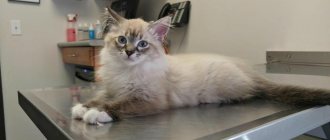What will you learn from the article?
- When to castrate a cat?
- Is it worth doing?
- How to prepare a cat for surgery?
- How does the operation take place?
- How to care for a cat after castration After local anesthesia
- After general anesthesia
- When to contact a veterinarian immediately
- Prices
By 6-8 months, cats reach sexual maturity, and the owners need to make an important decision - to castrate the cat or start looking for a bride for him. From the article you will learn what castration is, when it is performed, how to prepare a cat for it, what you need to know about this operation and the features of caring for pets after.
Castration of a cat is a surgical operation to remove the gonads from an animal.
After removing hair from the scrotum area, the doctor makes incisions, cuts off the spermatic cords, and removes the testes. The operation takes place under general anesthesia or local anesthesia.
When to castrate a cat?
At 6-12 months
According to veterinarians, the optimal age when cats can be castrated is from 6 to 12 months. At this age, the condition of the genital organs is ideal for surgery, and the influence of sex hormones on the animal is minimal. It is best to carry out the operation before the cat has time to “walk”.
What happens if you choose a different age?
If you castrate a cat too early, the animal's development may slow down. The level of sex hormones affects the rate of muscle growth. Early castrates can be smaller than their relatives and look like 10-month-old kittens until old age.
Castration too late (after 2-3 years) leads to the fact that the animal has already been formed under the influence of sex hormones and has certain habits. Therefore, after the operation the cat can continue to behave the same as before. The second disadvantage is that cats that were operated on late have a higher risk of developing obesity. Third, adult cats have a lower pain threshold, so the operation must be performed under anesthesia.
At what age should a cat be castrated?
At what age a cat should be castrated depends on his anatomy. So, temporary cryptorchidism is possible. Before the age of one year, the testes may descend. However, in the 2nd year of a cryptorchid cat’s life, the question of castration arises.
If the testes have the correct physiological location and the decision is made to castrate, the operation is recommended to be performed at 7-9 months. The lower limit is the beginning of puberty. By the 11th month it is usually completed.
If you operate on a kitten, there is a high risk of complications. They affect the urinary system. Adhesions form in its channels. They block the ureter. The process is triggered by inflammation that accompanies the recovery period after castration.
Meanwhile, young cats have narrow urinary canals. Inflammation, which adult animals tolerate easily, kittens endure with serious consequences.
Castration of a cat after 9 months of age is fraught not so much with health problems as with unwanted intercourse with females, fights for territory with individuals of the same sex.
Is it worth doing?
Pros:
- Change in behavior, lack of aggression;
- The cat stops marking his territory. Even if the instinct persists for some time after the operation (this is possible with late castration), the smell of urine becomes less pungent;
- The animal will not strive to leave its home - the risk that the cat will run away for a walk is reduced;
- The risk of developing malignant genital diseases is reduced several times.
Consequences (cons):
- The risk of the operation itself, performed under general anesthesia. To reduce it, do not neglect preparatory measures, carefully choose a clinic and veterinarian. Do not forget about a preliminary consultation with a veterinarian, choose modern anesthesia and procedure techniques.
- Risk of postoperative wound infection. Follow all doctor's recommendations, treat the wound, and prevent scratching and licking. If infected, contact your doctor immediately for treatment.
- Risk of pet obesity. After surgery, provide your cat with more active physical activity. Pay enough attention to your diet - reduce the serving size. After consulting with a veterinarian, switch the cat to specialized food for castrates.
Reasons for castration
The main purpose of the operation is to correct sexual behavior. A growing kitten becomes nervous and irritable. He marks the corners of the apartment with urine, meows loudly, and tries to find the cat.
This behavior is caused by the onset of puberty. The cat pesters its owners and suffers itself. But the main danger awaits the cat on the street. He may get lost or be seriously injured in a fight with rivals.
Castration has many advantages:
- Prevention of sexual diseases.
- Life expectancy increases
- Lack of desire to mark territory
Minuses:
- Possibility of postoperative complications
- Weight gain.
- Risk of developing genitourinary diseases
A timely operation will be effective and will not lead to negative consequences for your pet.
How to prepare a cat for surgery?
The operation is dangerous for an animal with a weakened immune system, in the presence of diseases and during the recovery period. Therefore, the decision about castration surgery should be made after examination and consultation with a veterinarian. And the animal must be properly prepared for it.
Preparation for castration surgery:
- Preliminary inspection. It is carried out by a veterinarian to assess the general state of health and identify possible contraindications to the operation. As part of the examination, urine and stool samples are taken. In some cases: late castration, breed characteristics (British and Scottish cats), examination by a cardiologist, ultrasound of the heart and cardiogram will be required.
- Vaccination. The cat must have all necessary vaccinations and undergo a quarantine period (3-4 weeks).
- Anti-flea and anthelmintic treatment. 3 weeks before the proposed operation, the cat must be removed from fleas and worms.
- Anti-stress measures. In case of increased nervousness and excitability of the animal, the veterinarian prescribes sedatives 2-3 days before surgery.
- Laxatives. As prescribed by the doctor, a laxative is given 12-24 hours before surgery. So that immediately after the operation the animal does not have the urge to go to the toilet. This can negatively affect the healing of the wound and cause pain in your pet.
- Fasting and drinking regime. The animal is stopped feeding 12-16 hours before surgery. Access to water is stopped 3-4 hours before the procedure. If the cat's stomach is full, the anesthesia can cause a gag reflex - this is dangerous.
Video about preparing for surgery:
https://www.youtube.com/watch?v=88l0Q9o3nfg
Indications and contraindications for the procedure
It is important for the owner to know and understand that the castration procedure is not suitable for all pets. In some cases, this operation is contraindicated or requires an individual approach. Such cases include: liver and kidney failure, heart and vascular diseases, anemia, exhaustion, as well as age restrictions.
In some cases, veterinarians insist on carrying out a castration procedure. For example, with such a pathology as cryptorchidism. Cryptorchidism is a congenital pathology in which one or two testicles do not descend into the scrotum. The animal may suffer from pain in the abdomen or groin area. Sometimes cryptorchidism leads to tumors in your pet. Therefore, castration in this case is extremely necessary.
The average price for an operation varies from 800 to 1500 rubles, excluding anesthesia. The total costs of the procedure, medications and other needs depend on the region of residence, the clinic and the characteristics of the animal. Sometimes the price can reach 5000 or 8000 rubles.
How does the operation take place?
The first thing a doctor does in a clinic or at home is administer anesthesia. The veterinarian selects the type of anesthesia depending on the pet’s condition after examination and its age.
- Intravenous anesthesia. The most effective and safe anesthesia. It goes away quickly and is easily tolerated.
- Intramuscular. The classic method is affordable.
- Inhalation. Expensive and complex, practically never used.
After the animal is put under anesthesia, the veterinarian removes the hair and disinfects the surgical area. A longitudinal incision is made in the scrotum area with a sterile scalpel.
The doctor removes the testis from the scrotum and ties the spermatic cord with a self-absorbing thread to prevent bleeding. After this, the testis (testicle) is excised. In a similar way, the doctor repeats the procedure for the second testis (testicle).
The wound is dried with a sterile cloth and treated with an antibiotic-based spray. In veterinary medicine, two surgical technologies are used: with self-absorbing sutures and sutureless. After the wound heals, a small scar of 1.5-2 cm remains.
Video:
Castration - pros and cons of the procedure
Puberty in cats requires the creation of certain conditions. Not all owners have this opportunity. When testosterone is produced in a pet (as nature dictates), the reproductive instinct awakens, which affects the animal’s behavior.
Since testosterone is produced on a regular basis, mating of the pet should not occur randomly, but regularly. According to veterinary reports, this should happen every 2 or 3 weeks. Violation of the cycle leads to deterioration in the health of the animal. Therefore, the only option is to reduce testosterone levels, which occurs after castration.
In urban apartment conditions, it is practically impossible to solve such problems. It is good when the animal is accustomed to the street and can independently cope with natural instincts. But these are completely different conditions: private, low-rise houses, dachas, etc.
Benefits of the operation
- life expectancy increases by 1.5 - 2 years, since the animal is protected from possible infectious infections and surges in the hormonal system;
- the pet stops marking indoors;
- The cat's behavior becomes calmer and more balanced.
Consequences of the operation
After castration, the following consequences may occur:
- in some cases, the pet’s activity decreases (here it is important to choose the appropriate diet);
- the possibility of having offspring is excluded;
- the effects of anesthesia may impair heart function.
How to care for a cat after castration
The nature of postoperative care depends on what kind of anesthesia was used: local anesthesia or general anesthesia.
General requirements:
- After surgery, your cat will have chills. Prepare in advance a secluded, warm place to rest. Change the bedding to clean and ironed cotton fabric;
- Do not place the cat in a high place. It should be located on the floor. After surgery and anesthesia, the animal will have poor coordination of movements and may fall;
- Move the tray closer to the resting place to make it easier for the cat to get to it;
- Remove litter from the tray. The granules can injure or clog the wound. Instead of filler, you can use disposable pet diapers;
- If the cat does not go to the toilet in the litter tray, and this can happen, do not scold the animal;
- If the cat tries to lick a wound, use an Elizabethan collar.
After local anesthesia
After local anesthesia, the cat is conscious and all that is required from its owner is to treat the postoperative suture (if necessary) with special antiseptic agents, as well as thoroughly clean the litter box after each trip to the toilet. The animal may be inactive and look for a secluded place - if this lasts a short period of time after the operation, then there is no need to worry.
After general anesthesia
After general anesthesia, the cat will sleep for some time, and when it wakes up it will be weakened and disoriented. While the animal is recovering from anesthesia, it walks poorly, staggers and can easily injure itself - do not leave it unattended!
Do not force your cat to drink or forcefully offer food. The first meal can be 8-12 hours after surgery - the food should be light and in small quantities.
If your pet has a dry mouth, you can drop a couple of drops of water into the mouth to moisten the tongue. Do not force-feed copious amounts of water. The animal will drink on its own when it fully recovers from anesthesia.
When to contact a veterinarian immediately
- After castration, the pet does not eat for more than 2-3 days;
- On the first day after surgery, an increase in body temperature is observed;
- The cat has difficulty breathing, paleness or severe redness of the oral mucosa;
- Swelling has appeared.
A cat's recovery after surgery is much faster than that of a cat after sterilization. This is due to the fact that cats have a less invasive operation, i.e. requires a minimal area of intervention with a low degree of tissue trauma.
Video - care after surgery
How to distinguish a neutered cat
Let's move on to the moment that will allow you to find out whether the cat is neutered or not. For clarity, we will divide the process into several stages.
Preparatory stage
- First, you should calm your pet. The test should not be carried out if the pet has just eaten, played or slept. Gently pick up the cat and lift his tail to examine his genitals. It is best if there are two of you and an assistant will hold the cat. In most cases, the animal will experience discomfort and anxiety. Perhaps he will try to scratch the owner.
- It is important to pat the cat on the back and talk to it. Perhaps the cat raises its tail on its own and will make it easier to identify. At the very least, the pet will calm down for a while.
- For personal hygiene, be sure to use gloves. They should not be thick so that the pet can be easily felt.
- Some problem occurs in long-haired breeds. In order to get to the genitals, the fur must be removed. By spreading the fur between the paws, you can see the cat's penis and anus.
- You should touch the cat carefully so as not to hurt the animal. If the cat is docile and obedient, you can put the cat on its back. This will make it easier to identify.
Checking the genitals
After castration (pictured), the cat has no testicles. This is the main sign by which the sexual activity of an animal can be determined.
IMPORTANT! Under the tail is the scrotum, it resembles a small pouch. Take it in your hands. Feel carefully.
If you feel small testicles, then the cat is not neutered with a 99.9% probability.
If the sac is soft, then the cat has undergone surgery. Let us note some nuances of the definition:
- There is no bag, which means the cat underwent surgery a long time ago, and it was deflated.
- One testicle is palpable. The cat is not neutered.
- It is possible that the cat is young and his testicles have not yet descended. It is also possible to suspect cryptorchidism - a disease when the testicles do not descend into the scrotum.
- Scars around the genitals are a clear sign of castration.
Other determination methods
If the owner does not have the opportunity or desire to use the above method, then there are a number of other methods:
- Measuring the distance between the anus and penis . You can use a ruler to measure the distance between the anus and penis. If the distance is more than 2.5 cm, there is a high probability that the cat is neutered. At a young age, the distance is 1.2 – 1.3 cm.
- Ask the former owners . The easiest way with minimal cost. Basic communication skills required. No need to be shy. A simple question to the former owners will save you from many problems and surprises in the future. If the pet is purebred, then there will definitely be a package of documents for it. There, among other things, it will be indicated whether the cat is neutered or not.
- Fur on the belly. You can pay attention to the lower abdomen. The fur there will be shaved. As a rule, for convenience, the veterinarian will shave off some of the cat's hair. The method is quite specific and does not provide a 100% guarantee. It is better to combine it with others for authenticity.
- Smell of urine. The urine of uncastrated cats has a persistent and very unpleasant odor. It may be difficult to understand the first time, but, as a rule, the smell of urine from neutered cats does not cause a negative reaction.
- Ear examination . If a cat is picked up from the street or taken from a shelter, pay attention to his ears. Often sterilized cats have a special mark. But, unfortunately, this method is not common in Russia. Shelters and volunteers simply do not have the ability to tag stray, sterilized cats.
- Contact an experienced breeder, friend or veterinarian. The latter person is preferable because, due to the specifics of the work, he can easily distinguish a castrated cat from an uncastrated one (see photo).
As it has become clear in practice, there are many ways to determine whether a cat is neutered or not. Some of them are more accurate, others are considered indirect signs. One way or another, caution, love and understanding for the cat will allow the owner to make the right choice.
Complications after surgery
The reaction to surgery is individual for each animal. After castration surgery for a kitten, the following complications are possible:
- Vomit. Typical reaction to anesthesia. If the cat vomits once and not profusely, make sure that the animal does not choke in the vomit. Turn the cat's head to the side. If vomiting is severe and uncontrollable, immediately inform the doctor who performed the operation.
- Hyperthermia. Fever, drowsiness and weakness are a normal reaction of the animal to surgery and anesthesia. This condition occurs in all cats in the first postoperative hours and can last up to 2 days. If the animal's body temperature is above 39°C and lasts more than 1-2 days after surgery, contact your veterinarian.
- Refusal to eat, lack of appetite. Fasting on the first day after surgery is normal.
- Reduced temperature. If the animal's body temperature drops below 37°C, cover it with warm heating pads. If this does not help, urgent medical attention is needed.
- Infection of a postoperative wound. Slight redness or swelling is allowed in the first 3-4 days after castration. If redness or discharge from the wound increases, you should seek help from a veterinarian.
- Inflammation of the stump of the spermatic cord. It can develop in cats in the first week after surgery. This is indicated by: lethargy, painful swelling at the operation site and an increase in the cat’s body temperature.
- Internal hemorrhage. You should be alert to: weakness and lethargy of the cat, drowsiness, pale oral mucosa (white). Each touch to the animal will cause a painful reaction in it. You cannot do without the help of a veterinarian.
- Obesity. Changes in the animal's hormonal levels after surgery cause metabolic disorders. He slows down. Possible weight gain. Do not overfeed your cat and create a balanced diet.
Important!
Stay close to your cat after surgery and contact your veterinarian if any suspicious symptoms occur.
Types of anesthesia
For castration, local or general anesthesia is used. Local anesthesia is used locally, on a specific area of the body, or the anesthetic is injected into several points on the body. After local anesthesia, the pet’s body recovers faster. Anesthesia is administered using a syringe.
General anesthesia involves certain risks to your pet's health. Before applying general anesthesia, the animal must be examined and checked for failures and disturbances in the functioning of the cardiovascular system.
During general anesthesia, anesthesia is administered in two ways:
- Injection method - the medication is administered intramuscularly or intravenously. Intravenous administration provides a quick effect and you can begin to act in 1 – 2 minutes. When administered intramuscularly, the anesthesia begins to act only after 20 minutes. This method can cause complications on the body. As a rule, it is used in relation to aggressive animals.
- The inhalation method involves administering anesthesia through the lungs. This type of anesthesia causes virtually no harm to the body. The risks are minimal. Recovery from anesthesia occurs in 3–4 minutes.
A combined method of anesthesia can also be used for castration. When it is necessary to immobilize a pet, they first use a sedative and then insert a tube into the mouth (in the case of the inhalation method).
What is the price
Russia
- Moscow and St. Petersburg – 1000 – 3000 rubles;
- Regions of Russia – 850 – 2500 rub.
Ukraine
- Kyiv – 350 – 900 hryvnia;
- Regions of Ukraine – 250 – 500 UAH;
Be careful when choosing a clinic. If a small and attractive price is indicated, it is quite possible that this is a marketing ploy with which they are trying to lure you.
A suspiciously low price for castration indicates that you may be additionally billed for anesthesia, medications and consumables. Take the time to find out everything in detail before you sign up for the operation.
Antisex or castration?
There are two ways to calm a cat: drugs to suppress sexual heat and castration. The experience of veterinarians shows that hormonal drugs damage the health of the animal, they damage internal organs - the liver, kidneys, cause urolithiasis and even malignant tumors.
The permitted age for this procedure is 6 months. However, it is best to castrate a cat at 10-12 months, when all the internal organs are already formed, the animal has reached sexual maturity, but has not yet begun the active mating season. If the owners postpone the operation until a later age, there is a danger that even after castration the male will continue to mark the territory.
Cats and contraception
Is it worth castrating a cat at home?
If you do not want to take your pet to the clinic or are unable to do so, consider having neutering surgery at home.
Features of preparing and performing surgery at home
- The animal is prepared in the same way as for an operation that is performed in a hospital setting;
- You need to prepare a clean room. A bathroom that is washed using household disinfectants, dried and ventilated is best suited. It is impossible to achieve sterility at home, but it is not necessary. Castration is not an abdominal operation;
- A table for surgical procedures is installed in the prepared room. It is also disinfected.
Pros:
- Saving time on transporting the animal to the clinic;
- The animal does not experience stress from transportation;
- After the operation, the cat is in a familiar environment, he recovers faster;
- There is no risk of infection from other animals.
Minuses:
- Inability to achieve sterility;
- There is no equipment for resuscitation measures. It may be needed if the animal has an individual negative reaction to anesthesia or medications;
- Calling a specialist to your home is more expensive and may depend on the distance of the house from the clinic.
Prices
Russia
- Moscow and St. Petersburg – 2200 – 3000 rubles;
- Regions of Russia – 1500 – 2500 rubles.
Ukraine
- Kyiv – 500 – 900 hryvnia;
- Regions of Ukraine – 400 – 500 UAH;
Price of the procedure
The price of castration of a cat ranges from 1-7 thousand rubles. The minimum is requested by standard budget clinics, and the maximum by private clinics.
A visit from a surgeon to your home is approximately 30% more expensive than an operation in a medical institution. The price partly depends on the region and the condition of the cat. Operating on cryptorchid, for example, is more difficult.
Castration is a simple operation. For comparison, the minimum price tag for sterilization is 3 thousand rubles. The request is due to the duration of the intervention, its complexity, and the cost of medications
Alternative methods of castration
Modern veterinary medicine also knows other methods of castration (sterilization) of cats. They are used as an alternative to surgery, but not as often as the classic method.
- Vasectomy (sterilization). It involves ligating the vas deferens. The cat loses the ability to have offspring, but does not lose the ability to mate. The operation is complex and expensive.
- Radiation sterilization. Targeted irradiation of the cat's reproductive organs (testicles). The method is rare, expensive, and requires special high-tech equipment.
- Temporary chemical castration. An implant containing a substance that suppresses the animal’s sexual desire is inserted under the animal’s skin. Expensive way.
- Hormonal temporary sterilization. Once every six months, the animal is given a hormonal injection that suppresses sexual desire. This manipulation is carried out for life.
Important!
All methods can be used to castrate a kitten, but surgery is considered the most effective and safest today.
Whether or not to castrate your cat is up to you to decide. But remember that not only we humans should live comfortably, but also our pets for whom we are responsible.
Types of castration
There are different surgical and chemical methods of castration of cats. The most popular and safest is surgery. Castration of a cat will prevent uncontrolled reproduction and uncontrollable behavior of the animal.
Surgical methods include:
- sterilization (palliative method consisting in ligation of the spermatic cords);
- Castration is a radical method in which the gonads are completely removed.
In the first case, the cat’s sexual desire does not decrease, sexual functions are not impaired, which does not cause changes in the animal’s behavior. The cat will mark its territory and scream to attract females. The character of the cat does not change either - he will defend his “male rights” to the bitter end. It is because of this that this method is unpopular.
A radical method is to remove the testes. It is carried out in two ways - open or closed. How is castration of cats carried out ?
- With the open method, the cat is given general anesthesia, the doctor cuts the skin of the scrotum and opens the membrane of the testicle. The testis is removed, the vessels are tied into a knot. There are no stitches.
- With the closed method, the tunica vaginalis of the testicle is not opened, and the testis along with it is removed from the scrotum. The whole operation takes no more than 5 minutes.
Chemical castration of a cat is a method of radiation exposure to the genitals of an animal. It has not yet become widespread, but specialists at the Lucky veterinary clinic in St. Petersburg recommend it as a safe, painless and reliable method.











